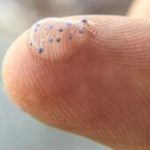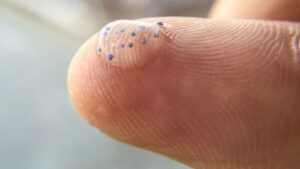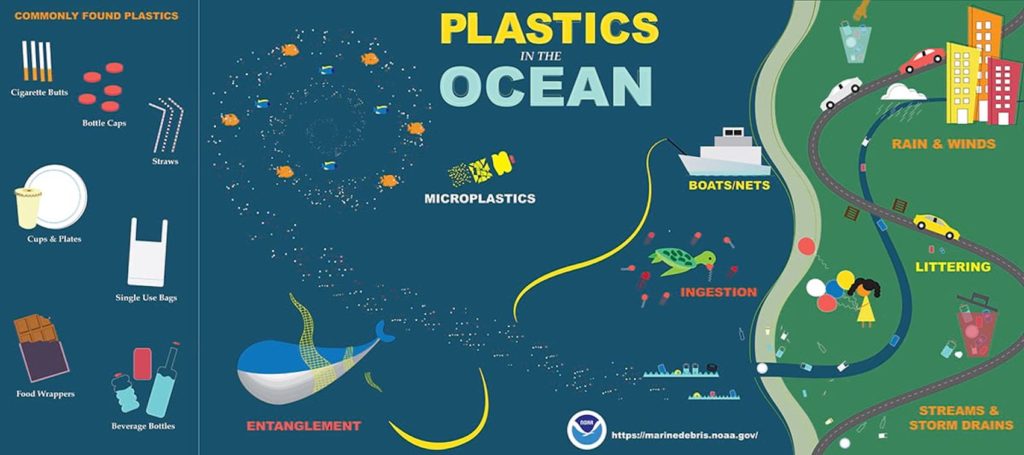
By Lindsay Levine and Dean Hickman
Envision the life-cycle of a single-use plastic item. Oil or natural gas is extracted from the ground, transported, chemically transformed into plastic which is then manufactured, transported to the point of sale, briefly used, and then tossed into the garbage. But it does not end there. Because of their durability, plastics last for hundreds of years and do not degrade meaningfully over your entire lifetime, except perhaps break into smaller pieces.
Now imagine that same process repeated for many of the items we use daily. Have you ever counted the number of single-use plastic items you use each day? Water bottles, paper coffee cups lined with plastic and their lids, diapers, hand wipes, masks, take-out food containers, chip bags, candy wrappers, the bag your newspaper comes in, produce and dry cleaning bags, and milk cartons (yes, they are lined with plastic), are all single-use plastics. Unfortunately, the list goes on and on. Multiply that by nearly eight billion people worldwide using single-use plastics regularly and you can easily see the plastics crisis we are facing.
Can’t I just recycle all of the plastic I use?
One of the most important things you need to know is that there are easy solutions to reducing your plastics consumption. But before we get to the good part, the recycling misconception needs to be clarified. If you think recycling is a “get out of jail free card”, think again. Less than 10% of the plastic produced is actually recycled. Sixteen percent is incinerated, and the balance ends up in a landfill or discarded on streets and waterways only to end up in the ocean.
This pollution is an environmental concern, and it kills wildlife via ingesting plastics and entanglement with large plastic debris, including plastic bags, six-pack rings, and fishing lines. In addition, plastics do not easily biodegrade. With the help of the sun and mechanical processes, plastics break down into tiny pieces called microplastics (<5 mm) and nanoplastics (<1 µm). The smaller particles can be inadvertently ingested by animals and make them sick.
While wildlife concerns of macro and microplastic pollution have been commonplace for decades, human health concerns are growing. Society continues to produce, use, and discard more than 130 million tons of single-use plastic annually. For context, the total amount of single-use plastic produced globally over the last five years is greater than the weight of every man, woman, and child on the planet (all 7.9 billion of us), yet there is no federal regulation limiting the production and use of single-use plastic.
Microplastics are found everywhere on earth, including the summit of Mount Everest, Antarctica, and here in Belmont. Take a stroll along the edge of Clay Pit Pond and look down for a local example of plastics—including microplastics—right here in Belmont. They are even in our food and water. Recently, microplastics have even been found to cross the placenta to expose the unborn. This is insanity on a global scale.
All is not lost; the solution to this dilemma is YOU! “Think twice before you use it once” is a great strategy when it comes to our use of single-use plastics. Breaking our apparent addiction may not seem so easy, but the good news is that there are easy ways you can cost-effectively reduce your plastic use.
How to Use Less Plastic
- Start by making just one change today. Maybe it’s switching to bar soap instead of liquid soap, using a reusable produce bag when you go to the farmer’s market, or taking a reusable mug to the coffee shop or reusable bag to the grocery store, or starting to carry a spoon for when you get ice cream. Every little bit counts.
- Beverage-related plastics, including straws, drink stirrers, beverage cups, coffee lids, and plastic bottles (water, soda, energy drinks) account for a lot of the plastic waste found on the streets of Belmont. Bring your reusable coffee mug to the coffee shop (or make your own at home), and carry a reusable water bottle with you. Not only will this significantly reduce your contribution to the plastics problem, but it might also save you money.
- Say no to the straw, the plastic stirrer, and plastic cutlery the next time you are out and about. Even better, keep a reusable set in your car or bag.
- There are many excellent plastic-free options for the bathroom and household cleaning including dental floss, shampoo, soap, laundry detergent, and dish soap.
- Take your reusable shopping bags or backpack when you go shopping for just about anything.
- Create a market for recycled plastic by choosing products with recycled content when you do buy plastic products such as trash bags, toothbrushes, clothes, carpet tiles, or lumber.
- If something looks like it is excessively wrapped in plastic, look for alternatives, or save your money and don’t buy it! For example, purchase loose spinach, lettuce, and kale and not the brands that are packed in the big plastic box.
- Support businesses that offer more sustainable or non-plastic options and talk to our local businesses about alternatives. Let your voice be heard and demand better for your health, our neighbor’s health, and the planet’s!
- Write or call your elected representatives in government and show your support for legislation that will guide us out of this mess. (Warren.senate.gov/contact/shareyouropinion; www.markey.senate.gov/contact/share-your-opinion)
- Doing something is better than doing nothing. Cheers to you on your plastic-free journey!
Lindsay Levine and Dean Hickman are cofounders of Clean Green Belmont, a recently formed group of citizens taking action against litter on Belmont’s streets and in Belmont’s waterways. They can be reached at cleangreenbelmont@gmail.com.




Sorry, the comment form is closed at this time.